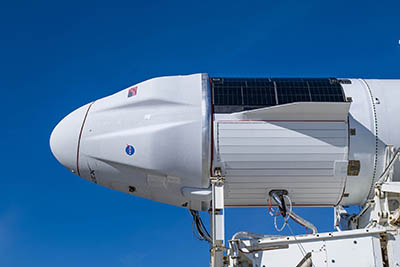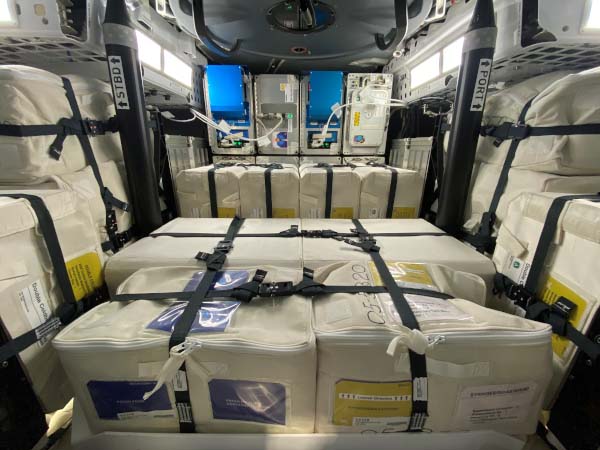By capsule, helicopter, boat, plane, and car, space station science experiments are about to make a first of a kind journey back to researchers on Earth.
Today (11 January), the SpaceX cargo Dragon spacecraft carrying out the company’s 21st commercial resupply services (CRS-21) mission for NASA undocks from the International Space Station, heading for splashdown off the coast of Florida about 12 hours later.
This upgraded Dragon transports significantly more science back to Earth than possible in previous Dragon capsules and is the first space station cargo capsule to splash down off the coast of Florida.

The upgraded version of SpaceX’s Cargo Dragon spacecraft, Dragon 2, is seen atop a Falcon 9 rocket on Dec. 2, 2020, as they prepare to be rolled out to Launch Complex 39A at NASA’s Kennedy Space Center in Florida for the company’s 21st Commercial Resupply Services (CRS-21) launch.
Credits: NASA
In addition, science returns from the space station through NASA’s Kennedy Space Center in Florida for the first time since the retirement of the space shuttle.
“I am excited to finally see science returning here again because we can get these time sensitive experiments into the lab faster than ever,” says Kennedy Space Center utilization project manager Jennifer Wahlberg. “Sending science up to space and then receiving it again on the runway was definitely something in the shuttle days that we really took pride in, and being able to rejoin that process is great.”
As the spacecraft returns to Earth, the experiments start to experience the effects of gravity again. Splashdown sets into motion rapid operations to return the samples and experiments back to researchers around the world. After a SpaceX boat scoops the capsule out of the water, a waiting team pulls time-critical science out of the spacecraft and loads it onto a waiting helicopter. The helicopter will deliver this science to shore a few hours after splashdown. Any remaining scientific cargo will come back either in a second helicopter load or stay aboard the boat and be removed at the port.

NASA astronaut and Expedition 64 Flight Engineer Kate Rubins works inside the Life Sciences Glovebox conducting research for the Cardinal Heart study. The biomedical research seeks to help scientists understand the aging and weakening of heart muscles to provide new treatments for humans on Earth and astronauts in space.
Credits: NASA
Space station experiments coming back include:
- Cardinal Heart, which studies how changes in gravity affect cardiovascular cells at the cellular and tissue level using 3D engineered heart tissues, a type of tissue chip. Results could provide new understanding of heart problems on Earth, help identify new treatments, and support development of screening measures to predict cardiovascular risk prior to spaceflight.
- A Japan Aerospace Exploration Agency study, Space Organogenesis, which demonstrates the growth of 3D organ buds from human stem cells in order to analyze changes in gene expression. Results from this investigation could show advantages of using microgravity for cutting-edge developments in regenerative medicine and may contribute to the establishment of technologies needed to create artificial organs.
- The Bacterial Adhesion and Corrosion experiment, which identifies the bacterial genes used during biofilm growth, examines whether these biofilms can corrode stainless steel, and evaluates the effectiveness of a silver-based disinfectant. This investigation could provide insight into better ways to control and remove resistant biofilms, contributing to the success of future long-duration spaceflights.
- Fibre Optic Production, which includes the return of experimental optical fibers created in microgravity using a blend of zirconium, barium, lanthanum, sodium, and aluminum. The return of the fibers, called ZBLAN in reference to the chemical formula, will help verify experimental studies that suggest fibers created in space should exhibit far superior qualities to those produced on Earth.
- Rodent Research-23, which involves the return of live mice. This experiment studies the function of arteries, veins, and lymphatic structures in the eye and changes in the retina before and after spaceflight. The aim is to clarify whether these changes impair visual function. At least 40 percent of astronauts experience vision impairment known as Spaceflight-Associated Neuro-ocular Syndrome (SANS) on long-duration spaceflights, which could adversely affect mission success.

JAXA astronaut Sochi Noguchi is pictured inside the newly arrived upgraded SpaceX Cargo Dragon vehicle on December 7, 2020. Safety goggles and masks are required when a crew member opens the hatch and enters a new spacecraft for the first time due to dust and debris that may have been dislodged during the ascent to space.
Credits: NASA
“Rodent Research-23 was designed to start studying rodent gravity readaptation responses as quickly as possible, making it an ideal candidate for this flight,”sayssaid Jennifer Buchli, deputy chief scientist for the International Space Station program at NASA’s Johnson Space Center in Houston.
The helicopter will land the experiments at the Shuttle Landing Facility (SLF), previously used for space shuttle return activities. Then a team will move most of the cargo to the Kennedy Space Center Space Station Processing Facility (SSPF) by truck, where science teams will be waiting.
“We are going to have a parade of researchers ready at Kennedy Space Center waiting to receive samples,” said Kennedy’s Research Integration Office utilisation flight lead Mary Walsh.
Traditionally used to prepare experiments for launch to space, the SSPF is home to world-class laboratories that provide the tools and workspace to immediately take data and analyse samples.
“The scientists will take a quick look to get initial results and then ship it back to their home bases,” says Wahlberg. “The benefit of being able to observe the science earlier is the ability to negate any gravitational effects on the research after it has been in space.”
From the hub at Kennedy Space Center, the science samples and experiments will head around the globe to California, Texas, Massachusetts, Japan, and more locations. “For every flight, we have hundreds of people all over the world preparing to put science on a vehicle. Likewise, we have all those people all over the world preparing to receive these items,” says Walsh.

NASA astronaut Kate Rubins poses next to cold stowage Polar Facilities in the SpaceX CRS-9 cargo Dragon spacecraft in 2016. The new cargo spacecraft has more powered locker space, enabling additional cold stowage space.
Credits: NASA
The large amount of science returning to Earth on this mission is possible thanks to upgrades to the SpaceX cargo Dragon spacecraft, which has double the powered locker capability of the company’s previous capsules. On return, it can support up to 12 powered lockers, enabling transport of more cold cargo and power for additional payloads.
“The old capsule was like a cream filled doughnut. You packed everything around the walls, and then in the middle we put a big giant stack of bags,” says Walsh. “This upgraded cargo Dragon is more like a three-story house. You put stuff in the basement, then you pack that second story, then you go upstairs and pack the third story. So it’s really different from a design perspective.”
This design also allows for quicker unloading of the research at splashdown, which, paired with the new splashdown location off the coast of Florida, gets scientific samples back to the researchers in record time.
“Using the previous Dragon spacecraft, it could take up to 48 hours from the time the capsule hits the water in the Pacific Ocean for it to be back in Long Beach, California. We then started distributing those samples about four to five hours after that,” says Walsh. “Now we are going to have early return science in hand and turn it over to researchers at just four to nine hours after splashdown.”

A look inside the upgraded cargo Dragon spacecraft as time-sensitive payloads bound for the International Space Station
on SpaceX’s CRS-21 mission are loaded. The spacecraft delivered more than 6,400 pounds of science investigations and
cargo to the orbiting laboratory.
Credits: SpaceX
On future missions, more scientists around the world can take advantage of these faster return capabilities to expand into new areas of microgravity research.
“This allows us to do different types of science,” says Buchli. “In the past if you wanted to watch an organism readapt to gravity, the best case was by the time you got it back to the lab from splashdown, you were getting data within 18 hours. However, you start to see gravity readaptation responses within organisms within 13 hours. This quicker return of just a few hours opens up a whole new area of science.”

A SpaceX cargo Dragon capsule sits atop a boat after successfully splashing down in the Pacific Ocean in 2012, ending
the first contracted cargo delivery flight contracted by NASA to resupply the International Space Station.
Credits: NASA

